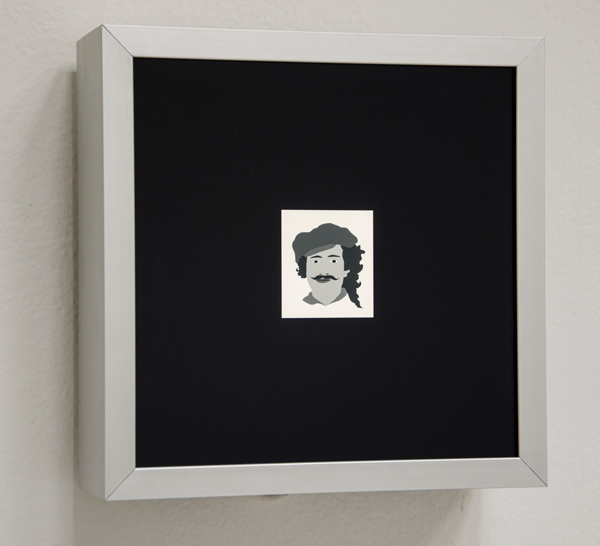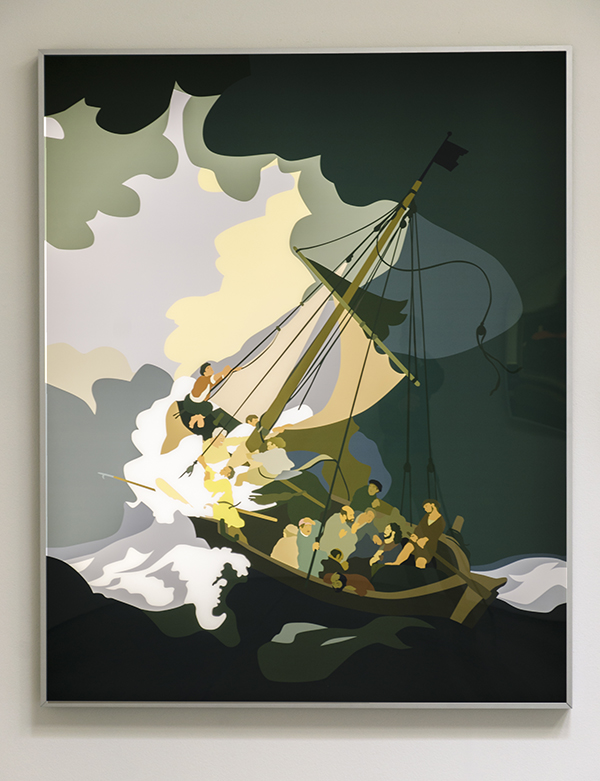In August 2015, 25 years after the still unsolved heist at Boston’s Isabella Stewart Gardner Museum (where thirteen works of art including three Rembrandts and a Vermeer disappeared), a videotape from the day before the robbery was released. Using this newly released footage as a point of departure, Kota Ezawa reduces the elements in the degraded original to flat cartoon-like shapes. Separating the footage to represent two points of view—what was captured inside and outside the guard’s door—Ezawa presents his animations on two small surveillance monitors at the gallery’s entrance. These videos serve as a reminder that despite surveillance technology, the crime was committed and remains unsolved.
In this compelling body of work,“Gardner Museum Revisited,”
Ezawa also recreates the stolen works to scale and installs them salon-style on a single gallery wall. He includes an image of one of the empty frames (in situ at the museum) directly across from this arrangement of surrogates, a nod to the fact that the thieves were very specific about what they took and how they removed it. A basic bench, like those found in museums, placed in front of these 13 light boxes, becomes a perfect spot for meditation and contemplation about these and other missing artworks.

Kota Ezawa, Portrait of the Artist as a Young Man, 2015, Courtesy of the artist and Christopher Grimes Gallery, Santa Monica, CA
Ezawa carefully distills the 13 stolen paintings, reducing them to flat forms—his signature style—so that they become unique new works based on recognizable imagery. The Duratrans prints within LED light boxes are titled by painting name, not by artist, suggesting they are well known enough to be recognizable, as well as generic enough to still be enticing. The largest in the array is the 62 x 50-inch The Storm on the Sea of Galilee (all works 2015). The smallest light box (8.5 x 8.5 inches) contains the tiny (1.75 x 2 inch) Portrait of the Artist as a Young Man. Both Rembrandt originals—a painting and an etching—are similarly reduced to flat, paint-by-number palettes.
Ezawa is as specific as the thieves about his source material and what he chooses to appropriate. In the past he has created enigmatic light boxes that reduced iconic images from the history of photography to basic shapes and forms, visually akin to the paintings of Alex Katz. In the Gardner works, Ezawa applies this process to reproductions of the stolen paintings and objects. Having also made animations culled from well known documentary footage—the O.J. Simpson trial as well as the Zapruder film of the JFK assassination—it is clear that he mines popular culture in addition to art and photo history to garner his source materials.
As obvious reproductions of reproductions, this project falls nicely into the canon of appropriation and the culture of quotation. Yet more specifically, the works are about absence, painted and photographic veracity, and the loss of originality. Although the stolen works are well documented and often presented online as blocks of stamp-sized pictures like the images in FBI most-wanted posters, Ezawa’s transformation gives them a new resonance and raison d’être.


